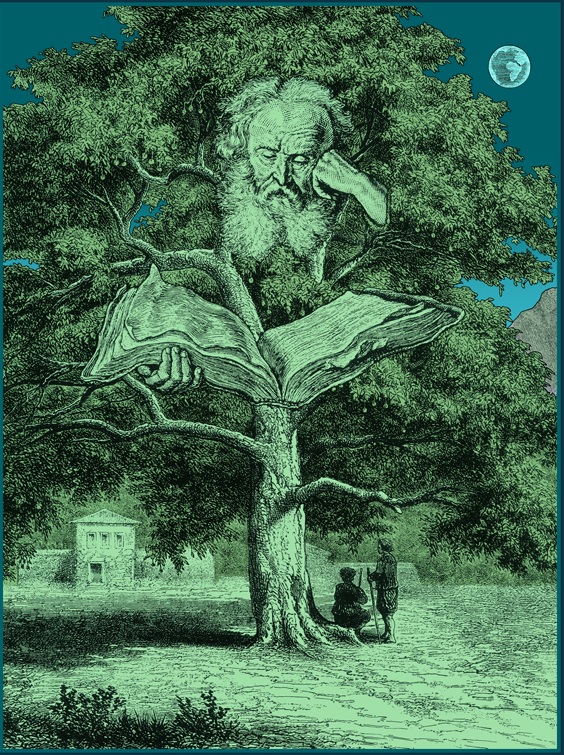
Poet Tree © Jim Harter.

I am saddened to report that the Neo-Surrealist painter Jim Harter died in San Antonio, Texas, on October 7 at the age of 74. Although few readers of this site will recognise his name, Mr. Harter was a key figure in the late Twentieth Century re-invention of Victorian aesthetics, and thus (albeit perhaps inadvertantly) one of the founders of the Steampunk subculture. He was also, for me personally, an old friend and a major artistic and intellectual influence.
Mr. Harter was among the first to recognise that the vast body of Nineteenth Century material placed in the public domain by the liberalised US copyright laws of the 1970s was not only an archive of the finished work of extinct generations but also a mine of raw materials capable of being turned into new and exciting creative productions.
One result of this insight --- of immediate practical importance --- was "Jim Harter's Pictorial Archive," a series of (so far as I know) 16 clip-art books published mainly by Dover from 1975 on. Each volume after the first focused on a single topic, whether broad --- Transportation, (1984) --- or astonishingly narrow --- Hands, (1985) --- and contained hundreds of royalty-free Nineteenth Century images. The pictures were in no self-evident order and (at least in the early volumes) had no indication of provenance. Abstracted not only from their original context but even from the larger illustrations in which they had originally appeared, the people and objects in the Archive acquired a startling novelty, like exhibits in a Wunderkammer. The last volume of the set, Scientific Instruments and Apparatus, came out in 2007, but the influence of the series was at its peak in the '80s and early '90s, just before the proliferation of clip-art online. The easy availability of these images -- and the fact that they were free! -- did not escape the notice of graphic designers working under deadline. "Harterisms" are nearly ubiquitous in the advertising and commercial art of the period, although little of the revenue they generated for others ever made its way back to him.
Mr. Harter himself, of course, was an artist and graphic designer of considerable talent. A student and colleague of Wilfried Sätty and a friend of René Magritte's student Jean Letschert (Swami Ascharyacharya), he used the images from his commercial archive to build astonishing collages somewhat reminiscent of Max Ernst's. Unlike the works of the early Surrealists, however, Mr. Harter's were not meant to depict the universe as disordered and irrational, but to manifest what he regarded as a cosmic wisdom beyond appearances. In no sense a "Neo-Victorian", Mr. Harter saw the Nineteenth Century as an unenlightened time when the mainstream culture had become so materialistic and divorced from the natural world that it had, ironically, acquired a sort of mediumistic quality, unconsciously displaying the Mysterium Tremendum it had consciously rejected. Because of this, Nineteenth Century imagery, for him, was an ideal vehicle to express the Philosophia Perennis. Most of Mr. Harter's works, however apparently bizarre, can be easily "read" (as he himself told me), some in the language of Jungian psychology, others in that of various mystical systems that interested him. In a few cases (especially some of the later paintings not based on collages) this is perhaps a bit too obvious, but even when the universal resonances of the work seem artificially induced, they still exist. An analogy, one which I think would have appealed to Mr. Harter himself, might be made to alchemical illustrations of the Seventeenth Century, which neither lose nor gain in emotional impact from their highly technical and programmatic character.
In 1982 and '83, Mr. Harter was the main design consultant to The Yellowhouse Press, an independent (arguably underground) radical newspaper in West Texas that, had it existed twenty-five years later, would have been considered Steampunk in the manner of the movement's serious British anarchist wing. It was entirely at his suggestion that the paper adopted its Victorian "Weird West" look --- never quite so Weird West as he had hoped. (He wanted to call the paper The Yellowhouse Canyon Ledger, and offered the image of a prospector dangling perilously from a cliff-face as its emblem!) The Yellowhouse Press, for which I also worked, long ago fell off the ledge of even regional history, vanishing with a disturbingly dream-like thoroughness into the canyon of oblivion, and Mr. Harter's influence on Steampunk was therefore mainly indirect and through the clip-art medium. Nevertheless, more than almost anyone else I have known he embodied the Retrofuturist ethos of remixing the past --- "fulfilling its karma," as he once said --- while avoiding the tiresome theatrical posturing so often associated with that attitude.
Mr. Harter faced many difficulties and disappointments in his life. Some were evils common to the human condition, some were the usual lot of the struggling and almost entirely unrecognised artist, and a very few (so he once told me in apparently complete seriousness) were due to the malevolence of Rakshasas, or goblins, who had trailed him home when he returned from India. I was unconvinced at the time, but it strikes me that Jim had precisely the traits most likely to antagonise wicked spirits, if they exist: he was calm, generous, humble, well-meaning, amazingly kind --- and, unlike most of us, he could see the invisible.
An obituary and appreciation of Jim Harter may be read in the October 10 issue of the San Antonio cultural magazine Rivard Report. The video of his works below is by Richard Autry: